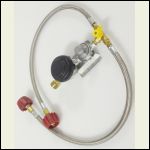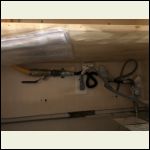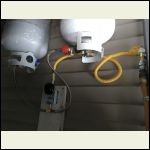|
| Author |
Message |
Mikete77
Member
|
# Posted: 3 May 2020 12:56am
Reply
Hi,
I am new to the forum and and I do not know my way around. I am also terrible with computers. Please, be patient with me!
I want to set up a gas stove and heater. I have 3/4†flexible pipe from the location of the tanks to the stove and heater. The cooktop came with a regulator that requires 10 to 14 lbs. I am planning of using two 40 lbs tanks with a manual changeover. I believe a need a regulator at the tank to bring the pressure within the limits of the cooktop regulator. Can anyone help me to decide what regulator and help me with the set up? The cooktop is a very nice one and it is rated at 90k.
The pipe to the tank as I mentioned is 3/4†and it have a 3/4 mip fitting. I would appreciate any suggestions and advice! Thanks.
|
|
ICC
Member
|
# Posted: 3 May 2020 11:00am
Reply
A couple of things---
Flexible pipe such as used for connecting home appliances like ranges, clothes driers, furnaces and water heaters are not meant to go through walls. You didn't give much information but did say that you weren't very conversant in the nuts and bolts of propane.
What kind of cooktop? Most are setup to use low pressure propane unless they are camping type cooktops that are meant for outdoor use. Typical home and RV cooktops and ranges are low pressure. Some may have a small regulator on the back. These are designed for propane pressure of 11" WC (water column) That is about 0.36 PSI. Regulators like those used for RV's cut the tank pressure down to 11" WC. I recommend getting an RV dual-stage auto changeover type of regulator for what you plan. That depends on the cooktop actually using the 11" WC pressure and not needing the higher pressure like a camp stove.
Post the make/model of the cooktop if you'd like anyone to confirm the specs.
Same for the heater; wall mount propane heaters and RV furnaces use 11" WC but others meant to connect to small propane cylinders are high pressure.
|
|
Nobadays
Member
|
# Posted: 3 May 2020 11:50am
Reply
Quoting: ICC Flexible pipe such as used for connecting home appliances like ranges, clothes driers, furnaces and water heaters are not meant to go through walls.
As ICC says.... you really should plumb with black pipe (non galvanized) from the tanks through the wall into the cabin. A shut-off needs to be installed at that point and then your flexible hose/pipe from there to the appliance.
|
|
Mikete77
Member
|
# Posted: 3 May 2020 05:52pm
Reply
Thank you for your fast response. The line that I am using is 3/4 in. CSST Corrugated Stainless Steel Tubing. The cooktop is a Jennair JGCP436HM00. ( a nice gift from my sons). The instructions that came with the cooktop said to use the supplied regulator. It further states that the regulator must have a minimum pressure of 10†WCP and a maximum of 14†WCP. The cooktop have 6 burners and they are rated from 9,200 to 20,000 BTUs.
Again, thanks!
|
|
FishHog
Member
|
# Posted: 3 May 2020 06:20pm
Reply
That is a standard propane regulator. If you have one at your tanks that is all you need. From that run black pipe into the building to a shutoff valve. From there your flexible pipe to your stove. 3/4†will be lots for your stove.
|
|
Fanman
Member
|
# Posted: 3 May 2020 07:07pm
Reply
Couple of things... regulators made for RV use may not be (probably aren't) legal for permanent buildings. You need a dual stage (sometimes called integral) regulator at the tanks, which will reduce the pressure to 10-14" of water (not pounds).
Flexible pipe is ONLY allowed between the shutoff valve and the appliance, a couple of feet. Between the shutoff valve and the tanks, it has to be copper tube (3/8" is fine if it's not too long) with flare fittings or black iron pipe.
On the tank side, a regulator, throw-over valve, and connections with POL fittings. I've purchased such things from propanewarehouse.com, but if you don't know what you're doing it might be best to hire a pro... gas explosions aren't anything to be treated lightly.
|
|
justinbowser
Member
|
# Posted: 3 May 2020 07:34pm
Reply
I am fixin' to go through the same deal. Can regular copper tubing be used from tanks to inside or does it need to be something special?
|
|
Fanman
Member
|
# Posted: 4 May 2020 01:38pm
Reply
Ordinary copper tubing is fine... but it MUST be used with flare fittings, compression fittings are a no-no. This means you need a flaring tool and to know how to use it.
|
|
|
justinbowser
Member
|
# Posted: 4 May 2020 11:12pm
Reply
Gotcha! Yeah, been making steel brake and fuel lines for many moons. Single flare OK or do they need to be doubled like brake lines?
Glad copper is OK, black iron pipe is a PITA to deal with and it's kinda pricey.
|
|
deercula
Member
|
# Posted: 5 May 2020 09:15am
Reply
Quoting: Mikete77 I am planning of using two 40 lbs tanks
I tried this with a 35,000 BTU direct vent propane furnace. Even (2) 40 pounders at once could not supply enough gas in cold weather. I now have a 100 gallon, 400+ pounds, tank that is filled by the local supplier. Look here for helpful info and discussion on this. https://www.small-cabin.com/forum/7_7640_0.html#msg110140
|
|
mj1angier
Member
|
# Posted: 6 May 2020 08:28am
Reply
Quoting: Fanman Flexible pipe is ONLY allowed between the shutoff valve and the appliance, a couple of feet. Between the shutoff valve and the tanks, it has to be copper tube (3/8" is fine if it's not too long) with flare fittings or black iron pipe.
I thought CSST was fine for runs from tank to shut off valve?
https://inspectapedia.com/plumbing/CSST_Gas_Piping.php
|
|
ICC
Member
|
# Posted: 6 May 2020 09:06am
Reply
CSST is fine for runs from tanks to point of use; when I hear flexy pipe I automatically think of those 12 to 48-inch flexy pipes that come with fittings already installed and which are designed only for the final connection from supply pipes to the heater, stove, etc. Be certain to follow the rules for protection from nails when running through studs, etc.
Of course, often local codes do not allow some practices or some materials.
|
|
Aklogcabin
Member
|
# Posted: 6 May 2020 11:15am
Reply
I also have the flex pipe from my tank to my supply line. Would be pretty hard to change the tank otherwise.
|
|
ICC
Member
|
# Posted: 6 May 2020 01:40pm
Reply
Flex (corrugated) or a hose?
|
|
Fanman
Member
|
# Posted: 6 May 2020 07:45pm
Reply
Single flare is fine for copper.
Like ICC I was thinking about the flexible connection kits, or the rubber hoses that are used on grills and some RVs. I've never worked with CSST.
I have copper between the regulator and tanks, it's flexible enough to change tanks.
One point of caution about flare fittings, if used outdoors where moisture freezing is possible then forged flare nuts must be used.
|
|
Mikete77
Member
|
# Posted: 6 May 2020 08:22pm
Reply
Thanks for all the input and advice. I ordered what I need and as soon as I get it, I will let you know how it went!
|
|
richard33
Member
|
# Posted: 10 May 2020 07:29am
Reply
[url=propaneheater.review]Propane[/url] tank installation is something that is to be performed by licensed propane companies only. Attempting to install your own propane tank is not advisable under any circumstance. Nor is it legal. See Tank Installation Estimates and Bids below for important advice before choosing what propane company installs your tank.
|
|
Fanman
Member
|
# Posted: 10 May 2020 07:56am
Reply
Quoting: richard33 Propane tank installation is something that is to be performed by licensed propane companies only. Attempting to install your own propane tank is not advisable under any circumstance. Nor is it legal.
I hate replying to an obvious spammer with only one post, but this is not correct. It depends on where you live and what the local rules are. I installed my own propane tanks and heating here in Connecticut, and it was totally legal. I did have to pull a building permit and the gas company inspected and leak tested the system before filling the tanks, but it was no big deal.
|
|
Mikete77
Member
|
# Posted: 10 May 2020 08:40pm
Reply
Thanks everyone for your input. I got it done and if it will help someone else here is what I used:
GR9450-MANC-SS- Compact Twin Stage (Dual Stage) Low Pressure Regulator
By the way, I am not a “spammerâ€, nor do I have any desire to harm or aggravate anyone. I just needed some information that would steer me in the right direction to do what I needed to do without going and spending big money for a plumber. If being new to the forum is reason to make others suspicious, how do anyone move to the lever of those judging the newbies? I apologize for disrupting the forum. I will do my best never to place anyone in the position that make them feel threatened! Thanks again for your help!
GR9450-MANC-SS Regulator
| 
93896E9F0DD54263A.jpeg
| 
E339A05B7ED34F7E8.jpeg
|  |
|
|
darz5150
Member
|
# Posted: 10 May 2020 09:34pm
Reply
Quoting: Mikete77 By the way, I am not a “spammerâ€
I believe he was referring to richard33. As per his quote box.
And I believe he is correct with this quote.Quoting: Fanman the gas company inspected and leak tested the system before filling the tanks, but it was no big deal.
|
|
FishHog
Member
|
# Posted: 11 May 2020 08:53am
Reply
Good work mikete and I know that spammer comment was not directed at you. Nothing wrong with your post that is what we are here for and I’m glad you got it done.
And your final results prove that Richards post was incorrect and nothing but spam
|
|
Mikete77
Member
|
# Posted: 11 May 2020 09:52am
Reply
Thanks. I really appreciate that there are places that we can come together to help each other. To share the knowledge we have been blessed with and give advice for those that are in need of it. Don’t ever steer away from that desire and work. We all need each other!
|
|
Fanman
Member
|
# Posted: 11 May 2020 01:55pm
Reply
Correct, it's richard33 that's the spammer, an incorrect and/or misleading post just get the [botched] link in. Unfortunately the archaic forum software here doesn't have a "report" function.
|
|
|

